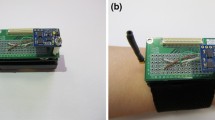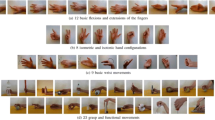Abstract
Monitoring and preventing diseases and infections are a significant challenge in the current state of our healthcare systems, given how it affects the patient mortality rates. Data analysis can aid in promoting these activities by recognizing risk factors and predicting the occurrence of any disease or infection. Predictive analysis algorithms provide useful tools for processing and analyzing the data. Furthermore, analyzing the body movements can assist in administering various rehabilitation processes and help regain the damaged or deteriorated motor skills of human beings. In this work, with the use of the Scatter Parameters (S11 and S21), we can identify the different human hand movements which are used in the kinesiotherapy process. For this work, a dataset is used, where the Transmission and Reflection coefficients of on-body Wireless Body Area Network (WBAN) antennas for each hand movement are depicted to exhibit unique channel functionalities with respect to frequency. This work focuses on the study of the classification of different limb movements by means of different predictive analysis algorithms. The goal of this work is to analyze and compare the results of these different predictive models to find the most accurate model for the purpose of classification. The classification accuracy of human hand movements comes out to be 85% when classifying using S11 parameters, and an accuracy of 99% when classifying using S21 parameters.



Similar content being viewed by others
References
Adami AM, Pavel M, Hayers TL, Singer CM (2010) Detection of movement in bed using unobtrusive load cell sensors. IEEE Trans Inf Technol Biomed 14(2):481–490
Alpaydin E Introduction to machine learning, Fourth edition
Anbarasi M, Janani V (2017) Ensemble classifier with Random Forest algorithm to deal with imbalanced healthcare data 1–7. https://doi.org/10.1109/ICICES.2017.8070752
Barakah DM, Ammad-uddin M (2012) A survey of challenges and applications of wireless body area network (WBAN) and role of a virtual doctor server in existing architecture. Third international conference on intelligent systems modeling and simulation, pp 214–219
Biswas D, Cranny A, Gupta N, Maharatna K, Achner J, Klemke J, Jöbges M, Ortmann S (2015) Recognizing upper limb movements with wrist worn inertial sensors using k-means clustering classification. Hum Mov Sci 40:59–76. https://doi.org/10.1016/j.humov.2014.11.013 (Epub 2014 Dec 19 PMID: 25528632)
Crosby G, Ghosh T, Chin C, Murimi R (2012) Advances and challenges of wireless body area networks for healthcare applications. ICNC, pp 99–103
Denisko D, Hoffman MM (2018) Classification and interaction in random forests. PNAS
Ghanou Y, Bencheikh G (2016) Architecture optimization and training for the multilayer perceptron using ant system. IAENG Int J Comput Sci 43(20–26):2016
Gomes HM, Barddal JP, Enembreck F, Bifet A (2017) A survey on ensemble learning for data stream classification. ACM Comput Surv 50(2), Article 23 (June 2017), 36 pages. https://doi.org/10.1145/3054925
Gopi AP, Jyothi RNS, Narayana VL et al (2020) Classification of tweets data based on polarity using improved RBF kernel of SVM. Int J Inf Tecnol. https://doi.org/10.1007/s41870-019-00409-4
Guraliuc AR, Barsocchi P, Potortì F, Nepa P (2011) Limb movements classification using wearable wireless transceivers. IEEE Trans Inf Technol Biomed 15(3):474–480. https://doi.org/10.1109/TITB.2011.2118763 (Epub 2011 Feb 24 PMID: 21349794)
Hall PS et al (2007) Antennas and propagation for on-body communication systems. IEEE Antennas Propag Mag 49(3):41–58
IEEE P802.15.6/001 (2010) Wireless Medium Access Control (MAC) and Physical layer (PHY) specifications for wireless personal area network (WPANs) used in or around a body
IEEE WLAN. http://www.ieee802.org/11/
IEEE WPAN. http://www.ieee802.org/15/pub/TG1.html
IEEE WPAN. http://www.ieee802.org/15/pub/TG4.html
Kaoudi Z, Quiané-Ruiz J-A, Thirumuruganathan S, Chawla S, Agrawal D (2017) A cost-based optimizer for gradient descent optimization. SIGMOD’17: proceedings of the 2017 ACM international conference on management of data, May 2017, Pages 977–992. https://doi.org/10.1145/3035918.3064042
Kwak KS, Ullah S, Ullah N (2010) An overview of IEEE 802.15.6 Standard. IABEL
Le T, Kim J, Kim H (2017) An effective intrusion detection classifier using long short-term memory with gradient descent optimization. 2017 International conference on platform technology and service (PlatCon), Busan, 2017, pp 1–6. https://doi.org/10.1109/PlatCon.2017.7883684
Mannini A, Sabatini AM (2010) Machine learning methods for classifying human physical activity from on-body accelerometers. Sensors (Basel, Switzerland) 10(2):1154–1175. https://doi.org/10.3390/s100201154
Mullainathan S, Spiess J (2017) Machine learning: an applied econometric approach. J Econ Perspect 31(2), Spring 2017, pp 87–106
Negra R, Jemili I, Belghith A (2016) Wireless body area networks: Applications and tec¹hnologies. Proc Comput Sci 83:1274–1281
Ongsulee P (2017) Artificial intelligence, machine learning, and deep learning. 2017 15th International conference on ICT and knowledge engineering (ICT&KE), Bangkok, 2017, pp 1–6. https://doi.org/10.1109/ICTKE.2017.8259629
Ruder S (2017) An overview of Gradient descent optimization algorithms. ArXiv, arXiv:1609.04747
Sagi O, Rokach L (2018) Ensemble learning: A survey. Wiley Interdiscip Rev Data Min Knowl Discov 8:e1249. https://doi.org/10.1002/widm.1249
Sagi O, Rokach L (2018) Ensemble learning: a survey. Wires Data Min Knowl Discov 8(4)
Salih ASM, Abraham A Intelligent decision support for real-time health care monitoring system
Salih A, Abraham A (2013) A review of ambient intelligence assisted healthcare monitoring. Int J Comput Inf Syst Ind Manage (IJCISIM) 5:741–750. ISSN 2150-7988
Saritas MM, Yasar A (2019) Performance analysis of ANN and Naive Bayes classification algorithm for data classification. Int J Intell Syst Appl Eng (IJISAE). https://doi.org/10.18201//ijisae.2019252786
Schmidhuber J (2015) Deep learning in neural networks: an overview. Neural Netw 61:85–117
Shi Z (2020) Improving k-nearest neighbors algorithm for imbalanced data classification. 2020 IOP Conf. Ser.: Mater Sci Eng 719
Sindhu S, Vashisth S, Chakarvarti SK (2016) A review on Wireless Body Area Network (WBAN) for health monitoring system: implementation protocols. Commun Appl Electron (CAE) 4:16–20
Sindhu HG, Sharma A, Mohta M, Rajawat A (2020) Hand movement classification from measured scattering parameters using deep convolutional neural network. Measurement 151, 107258, in press
Suthaharan S. (2016) Support vector machine. In: Machine learning models and algorithms for big data classification. Integrated Series in Information Systems, vol 36. Springer, Boston, MA
Ullah S, Ali M, Hussain A, Kwak KS (2009) Applications of UWB technology. CoRR abs/0911.1681
Zhang S, Deng Z, Cheng D, Zong M, Zhu X (2016) Efficient KNN Classification Algorithm for Big Data. Neurocomputing 195:143–148
Funding
No funding was received.
Author information
Authors and Affiliations
Corresponding author
Ethics declarations
Conflict of interest
On behalf of all authors, the corresponding author states that there is no conflict of interest.
Additional information
Publisher's Note
Springer Nature remains neutral with regard to jurisdictional claims in published maps and institutional affiliations.
Rights and permissions
About this article
Cite this article
Uday Ashish, P., Sharma, R.V., Gupta, S.H. et al. Classification of limb movements using different predictive analysis algorithms. Int J Syst Assur Eng Manag 13, 1385–1395 (2022). https://doi.org/10.1007/s13198-021-01484-2
Received:
Revised:
Accepted:
Published:
Issue Date:
DOI: https://doi.org/10.1007/s13198-021-01484-2




